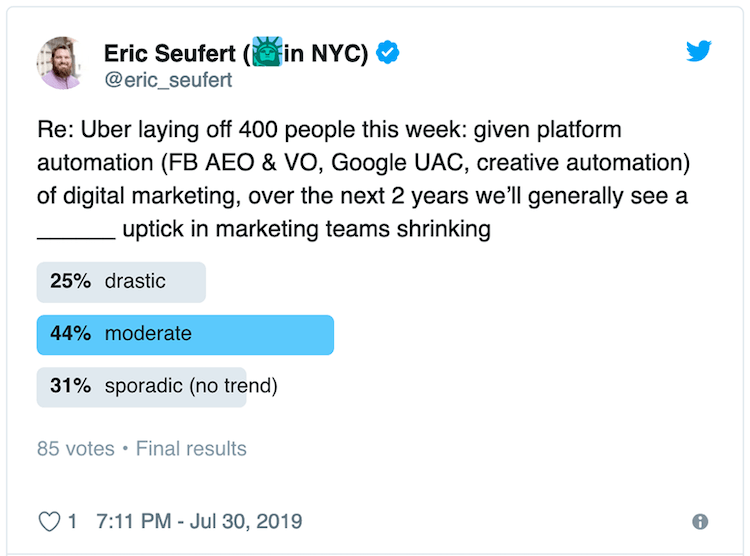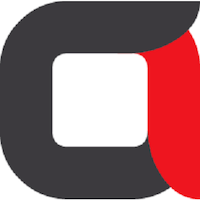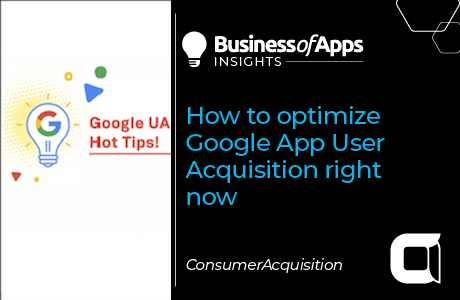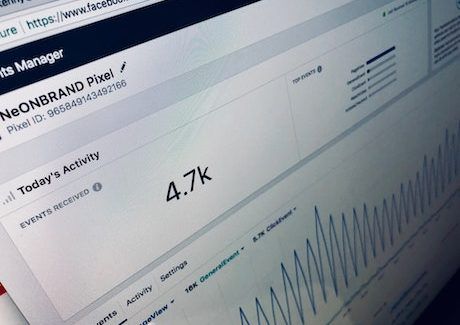It’s time to plan for 2020 – especially if you’re thinking about staffing and strategy. And with user acquisition strategy evolving at the rate it’s been, it’s smart to think several steps ahead.
2019 user acquisition advertising was all about change. We’ve moved several steps closer to having “the machines” – aka the advertising platforms’ algorithms – run more and more of daily campaign tasks. Namely, bid management and media buying.
UA automation has become a competitive advantage
Facebook pushed automation forward in several ways, including by making Campaign Budget Optimization mandatory. They also rolled out best practice approaches to total campaign management like their Power5. Google hasn’t held back, either. They’ve stepped back a little from a total “black box” approach, but they are still pushing advertisers to automate most of their campaigns.
What’s become clear in the last month or two is that the platforms aren’t just offering these automated features, and they aren’t just pushing advertisers toward them. Now, having human-managed campaigns has become an impediment. Not leveraging Facebook and Google’s new AI-driven automations like VO (Value Optimization), AEO (App Event Optimization), DLO (Dynamic Language Optimization), DCO (Dynamic Creative Optimization) and MinRoas Bidding (minimum Return on Ad Spend) make your business less competitive.
We expect this “automation as advantage” shift to become more evident – and more pressing – in the coming months. Both Facebook and Google are rapidly moving towards automation, possibly even total automation for certain types of advertiser profiles. And some market niches, like gaming, may be particularly ripe for expanded automation features. We’ve seen Google do this in the past with Google App Ads. Facebook usually isn’t far behind.
UA teams need to evolve… or maybe find new jobs
This shift towards automation is obviously going to take some work away from user acquisition teams. Smart UA managers will pivot over to creative strategy and testing. But if you had people on your team that were exclusively doing media buying or that were only adjusting bids or budgets and building new lookalike audiences … their desks may be empty soon.
So yes: Expect some layoffs and reduction in user acquisition team sizes in 2020. Even Uber laid off a third of its marketing department this summer. We suspect this is driven at least in part by new automation capabilities.
But here’s the doozy: The automation capabilities driving those layoffs aren’t just going to affect a small group of well-funded advertisers who have access to expensive adtech. The automations driving these changes in user acquisition advertising are available to everyone. Facebook and Google’s AI capabilities are free.
This could affect not just the user acquisition community, but also ad agencies, marketing consultants, and in-house marketers all over the world, especially those firms focus on the SMB market (small to medium size businesses). It takes less work and expertise to manage digital advertising than it used to.
Again, smart UA team members and other individuals will pivot to creative strategy, creative competitive analysis and creative testing and optimization. Or they’ll become specialists in how the algorithms work and in the new features the platforms are offering, like Google’s Pre-Launch tool, so they can better manage their remaining levers of control servicing the top end / most sophisticated advertisers. But their skill set has to evolve too.
CTV Growth Guide: A must-read for performance marketers
Whether you’re looking to boost brand awareness or drive user acquisition, this guide has you covered. Learn how to leverage CTV for both brand awareness and performance-driven campaigns and get actionable insights to optimize your strategies.
Download nowYou can’t be in an industry that’s evolving as fast as UA is and not radically and continually improve your skills. Otherwise you’re like a Morse code operator in a Verizon store. We’re just seeing that rate of evolution in the span of months instead of decades.
How the UA evolution affects employers
As you consider your own UA team now and for 2020, there may be an opportunity to reduce some overhead or hire less experienced media buyers who are less expensive. Team members must be agile, proactive, and strategic in how they manage both their time and the scope of their job description. Anyone who can’t do that may need to find another position.
So leaner UA teams are probably the future… and we mean “the future” as in Q2, 2020.
UA and Product Teams Will… Align, Overlap, or Merge?
So the roles of individual user acquisition teams may change. But the role of user acquisition teams as a whole may change, too.
For a long time, we’ve built a bit of an organizational wall up between acquisition teams and growth teams. The functions of these two teams were fairly separate: UA teams got the customers, and growth or product teams tested the app for better engagement, monetization, and lifetime value.
But is that separation really necessary – or even beneficial? As both teams are interested in LTV, and as advertising platforms simplify to the point where advertisers just give the algorithms a profile of the type of customer they want, and then send the algorithm out to get that type of customer, might it make sense to overlap or merge the staff and the functions of UA and product teams?
It’s essential to consider the role of creative development and creative strategy in all this, too. Ads use an awful lot of creative assets from the apps themselves. So could creative testing morph from a user acquisition role into aspects of product development? Could growth teams be influenced by user acquisition so that they develop different paths through apps for different types of customers?
Some companies are already exploring how UA teams and product teams can be more closely aligned. Creative and quantitative testing may be their common ground. And that could mean (among many other things) merged teams and thus some staffing redundancies.
Given the rate of change, we’ll know soon enough where it all goes.














